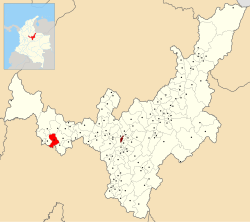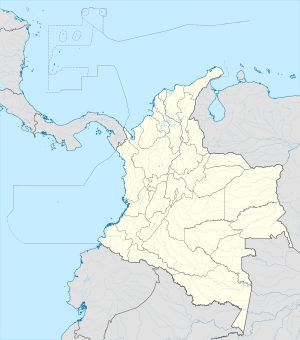Muzo
|
Muzo Villa de la Santísima Trinidad de los Muzos |
||
|---|---|---|
| Municipality and town | ||

View of Muzo
|
||
|
||
| Etymology: Muzo | ||
| Nickname(s): Emerald capital of the world | ||
 Location of the municipality and town of Muzo in the Boyacá Department of Colombia |
||
| Location in Colombia | ||
| Coordinates: 5°31′52.8″N 74°06′26.2″W / 5.531333°N 74.107278°WCoordinates: 5°31′52.8″N 74°06′26.2″W / 5.531333°N 74.107278°W | ||
| Country |
|
|
| Department | Boyacá Department | |
| Province | Western Boyacá Province | |
| Founded | 20 February 1559 | |
| Founded by | Luis Lanchero | |
| Government | ||
| • Mayor | Elin José Bohórquez Ariza (2016-2019) |
|
| Area | ||
| • Municipality and town | 147 km2 (57 sq mi) | |
| Elevation | 815 m (2,674 ft) | |
| Population (2015) | ||
| • Municipality and town | 9,040 | |
| • Density | 61/km2 (160/sq mi) | |
| • Urban | 5,350 | |
| Time zone | Colombia Standard Time (UTC-5) | |
| Website | Official website | |
Muzo (Spanish pronunciation: [ˈmuso]) is a town and municipality in the Western Boyacá Province, part of the department of Boyacá, Colombia. It is widely known as the world capital of emeralds for the emerald mines containing the world's highest quality gems of this type. Muzo is situated at a distance of 178 kilometres (111 mi) from the departmental capital Tunja and 118 kilometres (73 mi) from the capital of the Western Boyacá Province, Chiquinquirá. The urban centre is at an altitude of 815 metres (2,674 ft) above sea level. Muzo borders Otanche and San Pablo de Borbur in the north, Maripí and Coper in the east, Quípama in the west and the department of Cundinamarca in the south.
The town of Muzo was called Villa de la Santísima Trinidad de los Muzos, or simply Trinidad, when the Spanish conquistadors first founded the settlement in western Boyacá. Muzo is the autonym of the Muzo, the indigenous people who inhabitated the region before the Spanish conquest.
The median temperature of Muzo is 26 °C (79 °F) and the annual precipitation 3,152 millimetres (124.1 in).
Before the Spanish conquest of the Eastern Colombian Andes, the region of Muzo was inhabited by the people with the same name. They extracted emeralds in pre-Columbian times, giving them the name "The Emerald People". Using poles of hard tropical wood and water, the people peeled the emeralds from the formations, in particular the Muzo Formation, named after the municipality. Historians have estimated the Muzo settled in the area of Muzo around 1000 AD.
...
Wikipedia


